Interesting People #6: Josh Sawyer on Pillars of Eternity II
Pillars of Eternity set the record for crowdfunded videogames when its team of RPG veterans brought in over $4 million to fund for what promised to be the spiritual successor to Baldur’s Gate and its ilk. The game was an outstanding success, and its sequel, Pillars of Eternity II: Deadfire, surpassed even this amazing funding achievement to show that the computer RPG community is still very, very much alive and well. I caught up with Pillars II’s Game Director Josh Sawyer to discuss new features, community learnings and more.
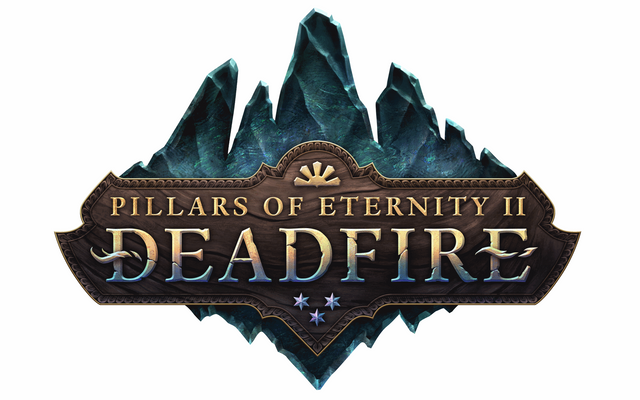
It's great to be talking to you about Pillars of Eternity II. Maybe we can just start off with a quick rundown from your latest update that you put out this week?
Josh: So, one of the things that has really been coming together is our combat is a lot clearer in Pillars II. One of the features that we highlighted in our update was the visual effects opacity blending. Some of the feedback we got for our combat was that the visual effects were overpowering – they would blow up the screen, they were super opaque – and so we changed how we render visual effects. We changed how we author the visual effects so that they are shorter and snappier, and then we put in that new rendering feature where as soon as you pause it lowers the opacity of everything. So overall, combining the feedback with all of the pacing changes we have made (such as the fact that it is a 5-character party now) I think that the combat is much, much easier to follow.
At the same time, overall I think that the tactical challenge in each individual combat is a lot higher. Our combats tend to be a lot more handmade – there are far, far fewer trash mobs. So I think that players are going to find that combat is easier to follow, but it is even more challenging than it was in the first game. Not in a frustrating way, but rather that the gameplay feels really good – it’s going in a good direction.
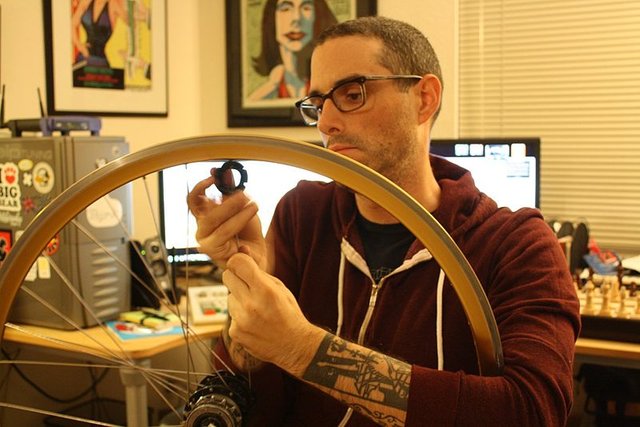
On top of heading up Pillars I & II, Josh’s past games include Icewind Dale I & II, Fallout New Vegas, Alpha Protocol and Neverwinter Nights 2.
You mentioned that the new combat system is more challenging – is there a lot more for players of the original game to learn? And how will the learning curve be for someone who is coming to Pillars for the first time?
Josh: I think it will be easier. For one thing, we’ve planned out our tutorials much earlier. In pre-production we talked about how we have a lot of things to teach the player, what are we going to teach the player and when, and part of that also means that the content we give to the player in the early game has to be paced in such a way that we’re not forced to introduce concepts before it’s time to introduce them.
So for example, in the first hour of gameplay, unless the player really goes off the beaten path and goes looking for it, they’re not going to encounter afflictions. Afflictions are the big mass of nasty status affects which hit the player. There’s so much other stuff to learn that afflictions are just not important in the early game. So our area designers, just for the first few areas, they don’t use enemies that inflict afflictions. We’re thinking ‘if we introduce those, we have to teach it, or we run the risk that players are not going to understand it, so let’s just wait a little bit before we introduce it’. And there’s a lot of little elements like that where we think, ‘look, we’re not ready to introduce this, so don’t put that in the early game’. Of course, the player is free to explore however they want, so they can go off the beaten path and find it, and that’s OK – but we designed the core content around this idea of really trying to gently and logically introduce concepts to the player as they go.
I think that overall, the system itself is clearer, the system is more consistent, there are fewer exceptions and edge cases for the player to learn, but it still is a really deep system to learn over time. I think it’s a lot more coherent and clearer, and that newcomers are going to have an easier time understanding Deadfire than they did Pillars 1.
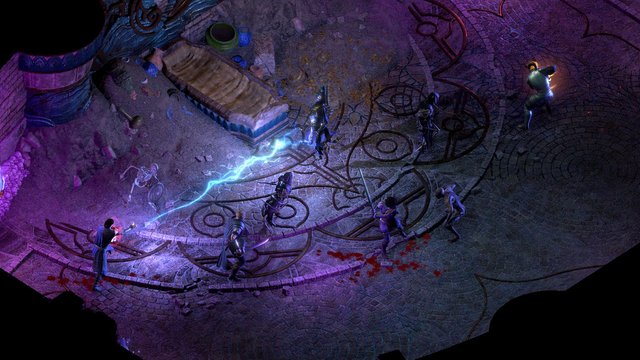 Pillars II will see numerous improvements to the combat, both visually and functionally. View full size.
Pillars II will see numerous improvements to the combat, both visually and functionally. View full size.
OK, that’s really good to hear. You’ve said how you took a lot of lessons from the community – is this one of those lessons?
Josh: Yeah. I mean, there are a lot of lessons we can learn from ‘the community’ – and the community is actually lots of little sub-communities. So there are people who want the ultimate challenge, where they do solo ironman, they do everything, all the bounties and dragons by themselves, and for them, they have mastered it backwards and forwards, but we can’t design the core of the game around those players. And we can’t really even design the whole game for classic hardcore players, although most of our difficulty when we’re designing is based around normal and hard. We kind of expect that to be our typical range. We have a lot of players who would expect that normal is going to be challenging but not crazy, hard is a bump up from that, and I think those really encapsulate most of our players. Then we find people who are more, “I’m new to this, give me a break” and that’s why we have easy and now we have Story Time. We introduced Story Time in Pillars 1 with patch 3.0, and this makes it super easy. And then we have Path of the Damned, but we’re not really designing around that.
When we look at the community we hear things on all sides – like “this is really easy to break” as well as “this is really hard to understand”, so we’re not making it for everybody, but for people who really want to get into the game, we try to look into ‘how can we design the game such that for our core audience and a reasonable number of outliers, like the super hardcore and the more casual players that are first coming in, how do we make the game either accessible or really challenging for them in a way that feels reasonable and doesn’t screw up the rest of the game?’. A lot of that is just reading people’s feedback and also watching people play. We get a lot of stuff out of watching people play that they don’t say. A lot of people say, “I think this” and “I think that” but when you watch how they play, sometimes how they play doesn’t match how they talk about the game. It really reveals that they don’t perceive certain things, and that our feedback needs to be better, or that the pacing needs to be superior, and stuff like that. So we learn a lot from what they say, but what we see on Twitch streams and YouTube channels reveals all that stuff.
I actually feel that I get more out of engaging with a conversation when they don’t know I’m reading or watching it. As soon as they know they’re engaging with the developer directly, well first there are tone considerations that go into it – I feel that it is more genuine and interesting when the interactions are player to player. I get a lot of that by going to the different communities and just seeing what they are talking about.
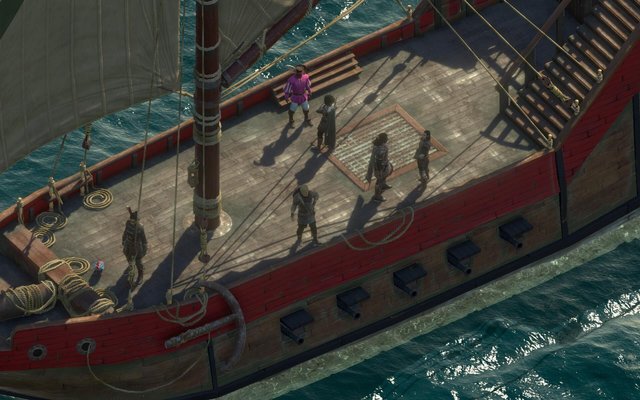 On top of numerous changes and improvements, Pillars II also introduces a ship as your mobile base of operations. View full size.
On top of numerous changes and improvements, Pillars II also introduces a ship as your mobile base of operations. View full size.
How do you guys stay on top of all these learnings?
Josh: Well, one of the things we’re working on integrating now is telemetrics. So, there’s a lot of subjective stuff you can get from observing Twitch and YouTube, and while we haven’t done it in a while, we do occasionally invite people in to play the game and then we’re in another room watching the feed. You can get a lot out of that. But telemetrics allow you to sort so much data from a larger pool – it goes beyond the anecdote of an individual player’s experience and you see a lot of patterns emerge, such as things they miss, or drop, what chests they open or don’t open, what paths they take through and in what order, did they notice a secret door, where they stop, or where they die, or where they quit playing. There’s all sorts of things that we can get out of that.
It’s not something that Obsidian has a ton of experience doing, but we’re realizing increasingly that there’s a lot of data that you can’t even get through polls. Polls, in a lot of cases, involves a specific community and a very specific type of player. I remember talking to a guy who did brand management for Lucasfilm, and he said, “who would you guess is the most popular character in the prequel movies?”. And I said, “I dunno, maybe like Jango Fett or someone like that?” and he said, “it’s Jar Jar Binks.” I said, “there’s no way” but he told me that if you go online and look at forums, then the answer you’ll get is that it’s never going to be Jar Jar Binks, but when you ask people anonymously in a different context outside of a community setting, a lot of people will then go for Jar Jar – often it’s kids or people who feel intimidated by online communities.
So it’s not that that’s the case with Pillars characters or anything, but what people tend to do versus what they say, especially within a community, can be very different, and telemetrics can tell a different story. It’s not that one story is the whole picture – it’s a matter of just getting more insight into informing our understanding of how people actually use the games that we make.
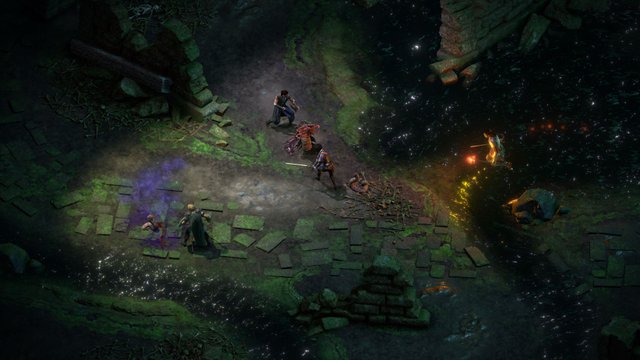 Pillars II will still be stacked full of the high fantasy that fans of the original love. View full size.
Pillars II will still be stacked full of the high fantasy that fans of the original love. View full size.
Sounds very interesting. On to the gameplay itself – can you please also talk about skills what you’re doing different in Deadfire that wasn’t in the original?
Josh: Well in Pillars 1, I wanted to solve a lot of problems that I saw in games that had parties. One of them is skill redundancy, where you have multiple characters that have the same skills and you’re thinking that that is just a waste of skill points, and you feel either you made a dumb character, or the companion that you have is dumb because you have overlapping skills so they don’t work, and also that some skills seem to come up in conversations and they were only for one character, and other skills were more applicable to multiple characters in a combat situation for example. So for Pillars 1 we really pared it down to a set of five skills that were useful to every character that invested in them. If you put points in Lore, you could use scrolls – it didn’t matter what your class was. If you put points in Stealth you could sneak around. If you put points in Athletics you could do a self-heal. All that felt very tight and solid, but it also did leave a lot of room for defining nuance in a character. Lore, for example, is very broad. History or metaphysics or religion are much more specific, so if you have a priest character, he could say, “well I know a lot about religion, but I’m not a historian” or “I’m a cipher and I’m interested in animancy and metaphysics” – the specificity of it allows the characters to feel a little more, well, specific and detailed and closer to a character concept and they can execute on that.
It's our responsibility to make the content really make use of all that stuff. We talked about it for a long time and the other thing that we did was we had a skill system where even if you have redundant skill overlap, other party members can contribute to the total.
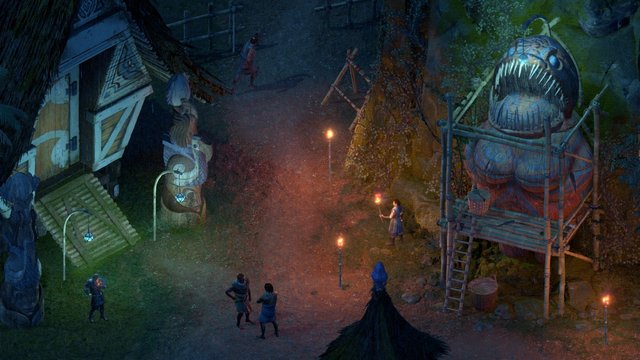 The new skill system will bring opportunities for even greater scripted encounters outside of combat. View full size.
The new skill system will bring opportunities for even greater scripted encounters outside of combat. View full size.
So they stack? Like if your character has x amount and a companion has x amount, the game checks against them cumulatively?
Josh: It’s not a 1:1 correlation, but it adds everyone’s together and there’s a triangular progression where they higher it gets the bigger the gaps are, but basically yeah, if you have a lot of people invested in a skill, it’s going to be a lot easier for you to make even really difficult checks. That way you can be, say, “I’m going to make a diplomacy party and I’m not dumb for doing that, I’m really just maxing that out”.
The other thing we did was to split skills into active and passive, so that for example you can have a skill like Metaphysics which has no gameplay benefit in that you can’t use it in combat, but you can use it in scripted interactions and conversations, so it’s a passive skill where the circumstance has to allow you to use it. And by separating the skills into two categories, we’re not saying to the player, “hey, invest in a skill that gives you a gameplay benefit or invest only in the roleplaying skills”. Rather, we have a pool of points for the gameplay stuff and then there’s a pool of points for the roleplaying-oriented or knowledge skills. So that sort of frees the player up to say, “OK, I don’t actually have to make this weird metagaming decision between these two things”.
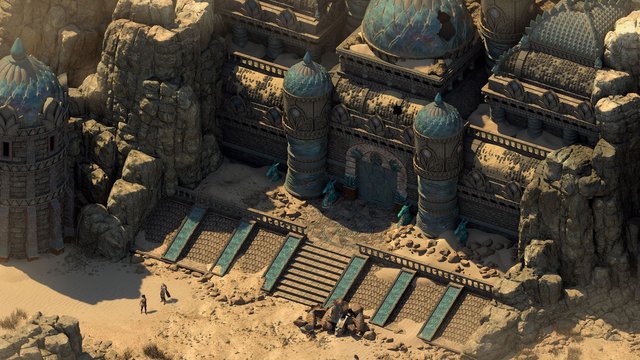
Locations like this just make you want to explore Deadfire’s world all the deeper, don’t they? View full size.
One thing I’ve read about and don’t fully understand is the difference between companions and sidekicks. Can you explain that a bit more, please?
Josh: Okay – so this has come up a lot. I guess the thing is, looking back at Baldur’s Gate 2 and the variety and amount of content that each companion had was humongous. The difference between Minsc or Jaheira or Aerie or Cernd or any of these characters could be really vast, and we knew that we wanted to make more in-depth companions for Deadfire but we also wanted more variety in terms of aesthetics or race representation or class representation. So there were character concepts we had, like Edwin who is the pale elf, where we thought, “that’s a cool character, but we’re already at so many companions…” because it’s a colossal amount of work to write all of these companions. It’s a lot of effort, and so we didn’t want to over-extend ourselves. So we thought, how about we make a category of character that has a unique portrait, a unique voice set, has their own little personality quirks – but we know that they’re not going to have their own personal quest and they’re not going to have big relationship arcs.
So it’s a way for us of doing what you see in some games where there’s just some companions that don’t have as much meat to them, but by calling them sidekicks we’re letting the player know that hey, this character doesn’t have a bunch of custom content for them. They’re a cool character but if you’re putting them in the party because you want to have all this other stuff to them, well, that’s not what they’re for. That’s why we made that distinction. Some people got mad about it, but I would rather be upfront about it and tell them that we have all these companions, but then we also have all these other people who aren’t as thoroughly developed, and we’re letting you know that so you don’t feel like you’re getting ripped off or tricked or anything like that. We’re not saying, “yeah we have 12 companions” but secretly four of them don’t really have any content to them. I don’t want to do that.
That’s the whole reason for doing the sidekicks: to give you more characters to choose from, but being upfront with the player and saying, “look, if you really want companions for relationships and quests and stuff like that, these are not the characters for that”.
Well, awesome – plenty to think about and look forward to! Thanks a lot for your time, Josh.
Josh: No problem!
Visit Obsidian to learn more about Pillars of Eternity II: Deadfire as well as to back the game, and follow Josh on Twitter here.
Previous:
Interesting People #5: Joel Manners, Lead Designer on Wing Commander: Privateer
Next:
Interesting People #7: Josh Sawyer on Fallout: New Vegas
Excellent post buddy. Appreciate the effort you put into your posts. Real high quality content. Keep em coming!
Thanks a lot! That's the plan - plenty more to come. :)
@badastroza I actually got into a very interesting and hella geeky exchange with Josh on Twitter - talking about swordfighting technique and terminology :D Again, I wish I had the funds to have backed Deadfire because it sounds like they ironed out a lot of the issues I had with the first Pillars, and I've seen some of their backer updates and the game looks extremely pretty. Ah well, maybe I'll convince them to give me a review key :)) Although I wouldn't hold my breath, considering I'm not even at the 1k mark with my YT subs :)
Can't hurt though - Josh may well remember you and be generous! But yeah, work on getting those numbers up!
I still need to play the first game... :p great interview.
Thanks for the feedback and the Resteem! If you're at all into traditional computer RPGs, Pillars is a good one. And now that it's a few years old it's often on sale really cheap. If you head to https://www.humblebundle.com/monthly you can pick it up now (and a bunch of other games) for only $12.
Already own it, and it's almost worth buying again at that price! :)
I only played through it for the first time a few months ago. Tough learning curve as it's not quite like any of the systems I've played before, but once I got over the hump in the beginning I really lost myself in the game for a good many hours' worth of play time.
This post got a
8.31% upvote thanks to @badastroza - Hail Eris !This post has received a 30.15 % upvote from @booster thanks to: @badastroza.